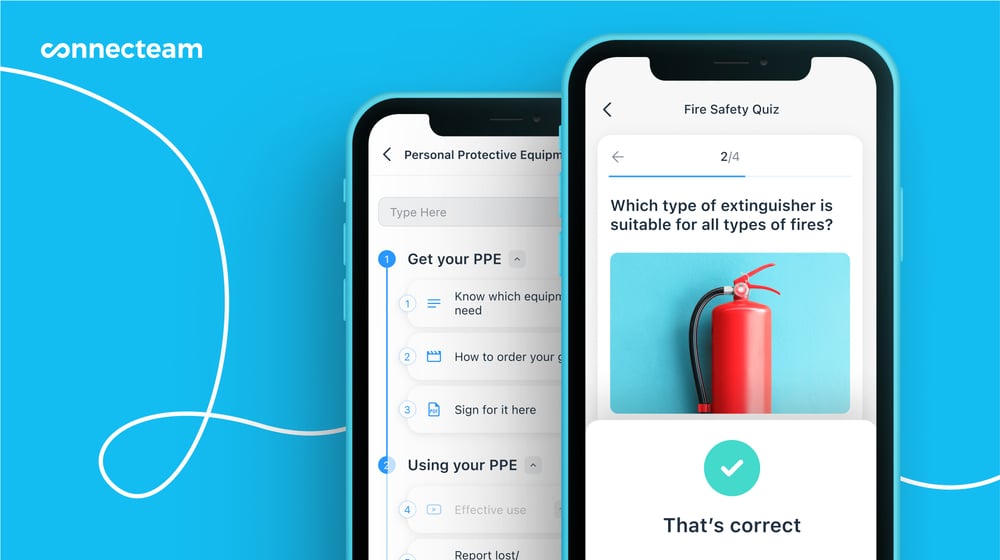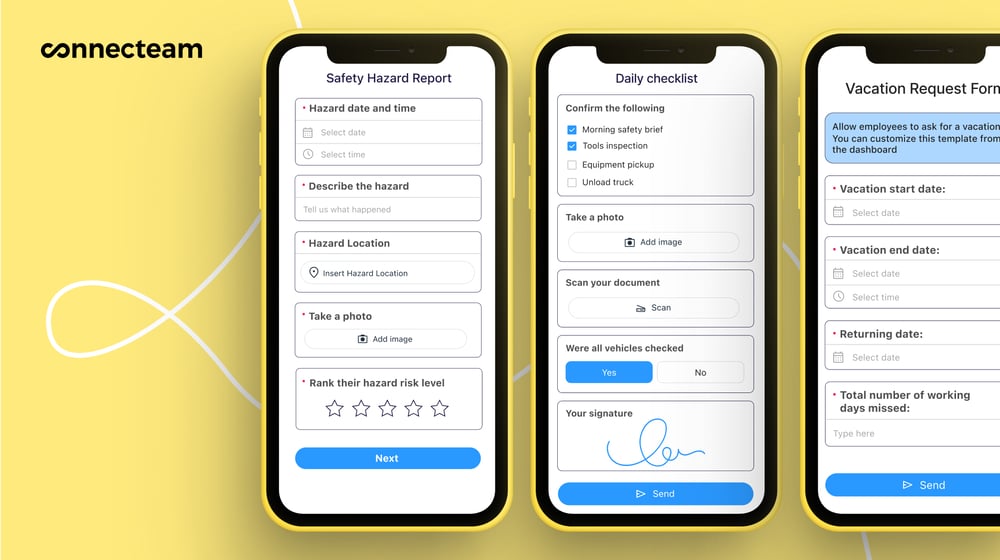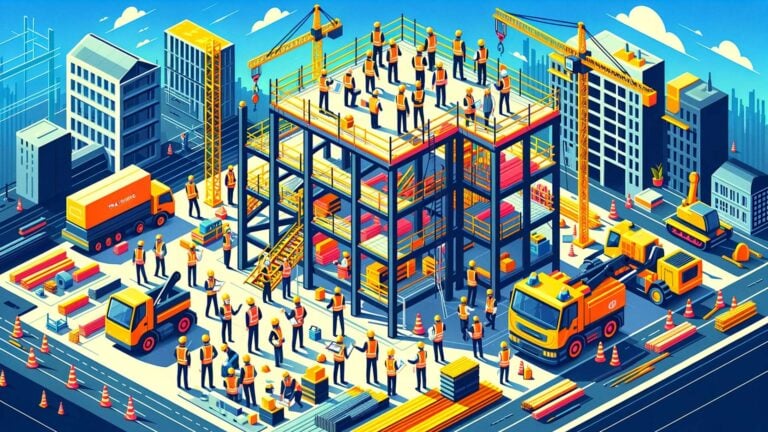An effective construction employee training program can improve productivity and work quality while keeping you compliant with safety regulations.
Improper construction worker training leads to safety hazards, low productivity, and quality issues. This puts your workers, customers, and overall business at risk.
That’s why providing your workers with proper training before putting them on projects is non-negotiable.
In this guide, we tell you everything you should know about construction worker training. You’ll learn about different types of training and how to deliver them.
We also share some best practices so you can build a team of qualified and productive workers.
Key Takeaways
- Construction worker training improves work quality and safety and keeps you compliant.
- Cover topics such as safety, tools and machinery, construction materials and techniques, and soft skills.
- Provide training through workshops, job shadowing, classroom-style sessions, e-learning, and written guides. Tailor the training method depending on the topic’s complexity.
- Use Connecteam to automate training and provide workers with impactful and engaging content.
What Actually Constitures Construction Worker Training?
Construction employee training refers to the process of providing construction professionals with the skills and knowledge to perform their jobs safely and effectively. Construction training courses aim to teach workers about these topics:
- Potential hazards, safety protocols, fall prevention, and so on. This helps minimize the risk of accidents and injuries on construction sites.
- Construction processes, such as reading blueprints and understanding construction materials and techniques.
- Working with tools, equipment, cranes, bulldozers, and other heavy or specialized machinery.
- Knowledge about building codes and regulations to meet legal requirements.
- First-aid and emergency response procedures to handle accidents and injuries on-site.
- Maintaining health and wellness in line with the demanding nature of construction projects.
- Soft skills training, especially in communication, collaboration, and time management.
- Workplace conduct training.
What Are the Types of Construction Worker Training?
Here are the different types of job training provided to workers in the construction industry.
Workplace safety training
Construction safety training is paramount when running any kind of construction business. Include the below topics in your safety training program.
Download our weekly site safety inspection checklist template and customize it for your needs
OSHA training
Construction management teams should be well-versed in workplace safety and compliance regulations set out by the Occupational Safety and Health Administration (OSHA).
Workers should learn to identify potential hazards. They must follow proper protocol when using tools and equipment and handling materials. Further, ensure they understand their rights and responsibilities, including recordkeeping and reporting. Finally, train them on how to report any OSHA violations or concerns.
Without this, your workers are at increased risk of workplace accidents and injuries. Plus, you could be liable for heavy legal fines for non-compliance.
PPE training
Educate workers on the importance of wearing personal protective equipment (PPE). Teach them to identify the appropriate PPE for different task types. Show them how to fit and adjust their PPE so they’re protected against injuries and long-term exposure to hazardous materials. Finally, provide training on inspecting and maintaining their PPE kits to ensure quality and safety standards.
Fall protection training
This training helps prevent falls from elevated surfaces like roofs, ladders, and scaffolding. Workers must understand how to use guardrails, safety nets, and personal fall arrest systems. They should also learn to inspect and maintain them. This mitigates the risk of falls and associated injuries and fatalities.
Download our fall protection site safety inspection report form template to keep your team safe.

Fire safety training
Educate workers on how to identify and control fire hazards. Teach them about the proper use of fire extinguishers and evacuation procedures. Inadequate response during fire emergencies can damage property and cause injuries or fatalities.
Electrical safety training
Help workers identify and prevent electrical hazards, including shocks, fires, or electrocution incidents. The program should cover safe wiring and installation practices and the use of appropriate PPE for preventing electrical mishaps.
Chemical safety training
Explain how workers can identify hazardous substances and use PPE in chemical handling. Also, discuss the proper handling, storage, and use of hazardous chemicals on construction sites. This training protects workers against accidents, spills, and contamination that could cause health issues or even death.
📚 This Might Interest You:
Sometimes, you could face workplace accidents or property damage despite training workers. Keep yourself financially protected with our complete guide to construction insurance.
Emergency response and first aid
Outline the steps to follow in the event of various emergencies, such as accidents, injuries, fires, or natural disasters. This includes:
- Activation of emergency response systems.
- Evacuation procedures and assembly points.
- Communication protocols.
- Coordination with emergency services.
Delayed response to emergencies due to lack of training can lead to health and safety issues and, in some cases, legal repercussions.
Additionally, train your workers to provide basic first aid. This includes wound care and bandaging, proper use of medical supplies, and treatment of burns, fractures, and sprains. Also, consider teaching them how to recognize and respond to allergic reactions.
Power tools, equipment, and heavy machinery
Your construction business training program must teach workers about operating power tools, equipment, and heavy machinery. Provide them with an overview of different tools, including drills, saws, power nailers and staplers, and jackhammers. Also, educate them on heavy machinery like excavators, bulldozers, forklifts, and cranes.
📚 This Might Interest You:
Download and adapt our comprehensive construction inspection checklist for heavy machinery and hand-held tools to ensure the safety of your construction crews.
They should understand the different applications of tools and machinery and how to operate them safely. This includes learning about load capacities and spotting issues like uneven terrains.
Further, include information about how to properly handle and store tools and equipment. Workers also benefit from knowing how to clean and lubricate their tools and inspect them for wear and damage. This can prevent tool malfunctions, accidents, and excessive downtime due to repairs and maintenance.
Construction calculations
Workers need a strong foundation in basic construction calculations—regardless of their roles. Here are some topics to include in your construction training.
- Interpreting blueprints and drawings correctly.
- Ensuring accurate measurements and layouts on construction sites.
- Calculating areas and volumes of structures—which is crucial for estimating material costs and pricing construction jobs.
- Making specialized calculations for concrete and masonry work, roofing, and surveying.
- Calculating quantities and costs for construction materials.
This type of construction employee training helps to prevent errors and reduces delays, financial losses, and legal complications.
Construction materials
Workers should learn about the different materials used in construction, including wood, concrete, steel, and so on. Include these concepts in your construction materials training:
- Properties of different materials and how to interpret their specifications and codes to ensure they meet industry standards.
- Use of appropriate PPE when handling different types of materials.
- Proper storage, transportation, and disposal of materials.
Improper training may lead to improper wastage, compromised structural integrity, and safety hazards. Create a clear Construction Quality Control Plan (CQCP) detailing how and who everything will be done.
Construction techniques
A robust construction business training program will equip workers with the skills and knowledge for various construction techniques. Without this, you could face structural issues in your project. Worse—your company could be fined for non-compliance. Here are some examples of topics to cover.
- Welding training will help them weld properly and safely.
- Rigging and slinging training focuses on the safe lifting and movement of heavy loads.
- Trenching and excavation training covers safe digging and the creation of trenches. Workers are also taught about soil stability and using protective systems.
Construction industry regulations and compliance
Workers must comply with the strict regulations that govern construction. Here are some key regulations to teach.
Building codes
These provide a framework for construction professionals to design, construct, and maintain structures in ways that minimize the risk of hazards and ensure structural integrity. For instance, some codes dictate acceptable materials and construction methods. This helps ensure durability, stability, and resistance to environmental factors.
Zoning ordinances
Zoning laws regulate the use of land and the types of structures that can be built in specific areas within a municipality. For example, a residential zone may have a restriction on a building’s height. Construction workers must understand and adhere to these laws so your company remains compliant.
Environmental regulations
Workers must understand and follow environmental regulations. These could relate to waste disposal and sustainable construction practices, for instance. This way, you can ensure safety and compliance.
Soft skills training
Though construction is technical, workers must develop certain soft skills to work effectively. Train workers on the following soft skills to improve productivity and efficiency in your construction teams.
Communication
A lack of effective communication in construction can result in errors, delays, and other issues that hamper work. So, providing workers with communication skills training is essential. Clear communication ensures that your entire team is aligned on goals, tasks, and timelines.
Collaboration
Construction projects involve diverse teams working together. Collaboration skills training is a great way to help employees work cohesively, resolve conflicts, and contribute to shared goals.
Time management
Construction workers need to adhere to strict project schedules and deadlines. Time management training can help them learn to prioritize tasks and allocate resources effectively.
Adaptability and problem-solving
Construction projects often face unexpected challenges. For instance, your workers might have to deal with a sudden change in weather conditions, an extended power cut in the location of their job site, or a changed client preference. They must adapt and find solutions that minimize disruption and keep things moving.
📚 This Might Interest You:
A productive, efficient workforce helps ensure client satisfaction and win future clients. But that’s not the only way to get clients. Curious to learn more? Read our guide on how to get clients for your construction business.
Workplace conduct training
The Equal Employment Opportunity Commission (EEOC) recently spotlighted the prevalence of discrimination and harassment in the construction industry, especially against women and people of color. Workplace conduct training should aim to prevent discrimination and harassment by covering the following topics:
- What constitutes discrimination and harassment in the construction industry (including discrimination and harassment against clients, subcontractors, and so on).
- Clear guidance on how to report workplace incidents of discrimination or harassment, and an overview of the procedures that will follow a report.
- Specific training for those in leadership positions on their responsibilities to prevent and address discrimination and harassment.
How To Deliver Construction Worker Training
You can use several training methods to train your workforce effectively.
On-site training and workshops
In-person group training conducted at the construction site is ideal for hands-on demonstrations, equipment training, and project or site-specific tasks. For instance, companies needing to adhere to strict waste disposal laws can show teams how to follow the rules through a quick, on-site workshop. This is a great way to encourage active learning through direct experience and practice.
🧠 Did You Know?
Use Connecteam as a company event app to create workshops and invite workers to attend. Send reminders, track RSVPs, and share relevant information to save time and effort.
On-the-job learning and peer-shadowing
Individual workers can learn certain tasks live on the job through support from their line managers and peers. For instance, a manager can train their worker on how to use a new tool while at work. Or, a new worker could shadow an experienced peer for a few days to learn about work and company protocols.
This is a cost-effective and hands-on way of learning. Plus it promotes collaboration between team members. But, it’s probably not the best solution for high-risk tasks—like operating a crane—that require more-extensive training.
Classroom training
Inviting workers to attend in-person or virtual training sessions led by instructors works well for teaching theoretical concepts, including safety and compliance regulations, company protocols, and so on. It allows for live interaction and feedback, which improves learning.
However, it can be more expensive—especially if you’re using an external trainer. Plus, construction companies without physical offices may need to rent spaces for in-person workshops.
E-learning
This refers to online training delivered through digital platforms. You can roll out training courses and modules straight to workers’ mobile devices, tablets, or laptops. This way, they can complete their training on the move.
E-learning may not be suitable for application-based learning—such as administering first-aid. But, it’s a cost-effective and efficient way to provide compliance training, OSHA training, and other general knowledge.
📚 This Might Interest You:
Explore the 6 best e-learning apps for business in 2025.
SOPs and training manuals
Create comprehensive written guides covering various aspects of construction work. For example, you could include safety protocols, regulations, and emergency response processes.
You could take it one step further and provide standard operating procedures (SOPs) for certain repetitive tasks. For instance, you could write step-by-step instructions alongside supporting images for operating equipment.
🧠 Did You Know?
Connecteam’s company knowledge base lets you store all your training manuals and guides in a central location that workers can access from their smartphones. Store PDFs, text, and images—or even add podcasts and video tutorials for better engagement and learning.
Workplace safety drills
Put workers through practical exercises resembling real-life emergency scenarios. For instance, conduct regular fire drills or simulate medical emergencies to ensure workers are current on the necessary protocols.
Simulations and virtual reality (VR)
With technology advancements, you can now create virtual environments that simulate real-world construction scenarios. These are effective for teaching employees about risky or complex tasks in a safe and controlled environment.
Best Practices When Providing Construction Worker Training
Adopt these best practices when creating and delivering your construction business training courses.
Make learning simple and engaging
Simple and engaging content helps workers understand and retain information better. Your training program might use these strategies.

Quizzes and tests
Consider adding quizzes and assessments to your online training courses to check if workers remember their topics. This is great for making learning engaging and enables better knowledge retention.
🧠 Did You Know?
Connecteam lets you add quizzes to the middle or end of your training modules. You can even track workers’ quiz results from a central dashboard.
Microlearning
Microlearning involves breaking down complex topics into bite-sized chunks. For example, instead of conducting a lengthy training session on construction calculations, you could break it down into short, focused modules.
Each could cover a specific aspect, such as calculating concrete volumes or estimating material costs. This way, workers can learn and absorb each concept separately, enabling better retention.
📚 This Might Interest You:
Read our reviews of the 7 best microlearning platforms for 2025.
Provide continuing education
Construction training isn’t a 1-time learning experience. For instance, you can’t roll out 1 e-learning module about safety protocols or provide new hires with training only during onboarding and be done. If you do this, workers might forget something in a real-life situation, putting your company at risk.
Here are some ways to ensure that workers retain and apply their knowledge in real life.
Deliver training regularly
Consider rolling out training programs regularly. How often you do this depends on the nature of the topics. For instance, you can deliver compliance training every 6 months to ensure that workers are always current with evolving compliance protocols. On the other hand, you could deliver specific equipment operation training less frequently, perhaps annually, as long as there are no significant changes in machinery or procedures.
Use on-site checklists for high-priority tasks
Create structured lists outlining steps or items workers must complete for safety protocols, quality control, and other critical tasks. This way, you’re not relying on workers to memorize everything they must do. This reduces the chances of missteps and errors.
🧠 Did You Know?
Connecteam lets you create digital forms, including checklists, from scratch or by using templates. Workers can fill these out at job sites from their phones, and you can track incident reports, safety checklists, and more in real time.
Add job aids to job sites
Create job aids—quick reference materials, charts, and diagrams—that provide immediate guidance on specific tasks. For instance, a diagram could show how to operate a machine, and you could place it right by the machine. This way, workers can brush up on the process quickly before using the machine rather than relying solely on their memory.
Create safety posters
Visual aids displaying safety guidelines and hazard warnings are effective ways to prevent workplace injuries, accidents, and more. For example, having a hazard warning placed near toxic chemicals will constantly remind workers to wear appropriate PPE before working with the chemicals.
Enable easy knowledge transfer
Construction businesses face high turnover rates. This means you might need to replace fully trained workers and train their replacements—which is time-consuming and expensive. That’s why you should use transferable and reusable training materials whenever possible.
For instance, create comprehensive guides and SOPs and store them in a central drive so new workers can access them any time. Or, craft custom e-learning courses and roll them out to every new hire.
💡 Pro Tip:
If feasible, consider creating several copies of training manuals and guides in different languages. Construction workers often hail from various backgrounds. Enabling them to learn in their first language might prevent translation errors that could lead to on-the-job mistakes.
Don’t forget career development
You should also focus on helping your construction workers develop their careers. Conduct regular check-ins to learn about their goals, provide them with feedback, and gather feedback on their employee experience.
You might, for example, consider sponsoring construction certifications to help workers advance their skills and knowledge. Similarly, as your workers progress, they may want to apply for licenses enabling them to do other tasks, such as operating heavy machines (like cranes or forklifts). Providing them with training and funding for their licenses is a great way to support their goals.
Also, consider adding other soft-skills training in addition to communication and time management training. For instance, help workers improve their leadership skills. This can help them become construction managers or contractors in the future.
Additionally, consider pairing them with mentors. Mentors can be senior or experienced employees in your company or other industry leaders who volunteer to help. This can keep them driven and make them feel valued.
Development initiatives like these help to increase engagement levels. Plus, it might reduce turnover.
Use technology to streamline construction worker training

Today, many great training solutions can help to streamline and simplify your training programs. Connecteam, for example, offers several powerful tools to enable training and knowledge sharing.
Build courses entirely from scratch or use one of Connecteam’s premade courses or templates on the employee training app. It offers multiple formats and easy drag-and-drop tools. Add quizzes to make it interactive and interesting.
Deliver these straight to your workers’ smartphones or tablets so they can complete them from anywhere. Use these courses to train your existing workforce or onboard new employees. Further, send reminders and track progress from your admin dashboard.
Additionally, the company knowledge base lets you store training materials in many formats— with no storage limit.
Finally, workers can access and complete digital checklists for important tasks, and you can track these in real time.
Get started with Connecteam for free today!
💡 Pro Tip:
Check out Connecteam’s template library for checklist templates across a variety of industries.
Bottom Line on Construction Worker Training
Proper training is essential in a highly regulated industry like construction. One misstep and you can risk your workers’ and customers’ safety, face legal fines, and more. An effective training program will cover everything from construction materials, techniques, and calculations to the use of PPE, power tools, and heavy machinery.
Deliver theoretical concepts such as compliance training through e-learning. Share safety protocols and repetitive tasks through guides and SOPs or digital checklists workers can access on the job. Also, support on-the-job training and workshops for complex and technical training.
Finally, consider using training software like Connecteam. It offers simple and cost-effective tools to create and deliver construction worker training courses from anywhere.
FAQs
How can I provide construction worker training on a low budget?
Avoid engaging external training facilitators, as their fees and travel costs add up. Instead, use experienced employees from your workforce to run in-person or virtual sessions and workshops.
Also, consider Connecteam to deliver e-learning courses and training guides. It’s free for small businesses with up to 10 workers.
How can I retain my fully-trained construction workers?
Conduct regular check-ins with workers to provide and seek feedback and discuss their career goals. Further, invest in training and development to support these career goals. Finally, if it suits your budget, pay them above-market rates. These strategies can improve worker satisfaction and retention.


